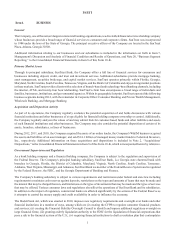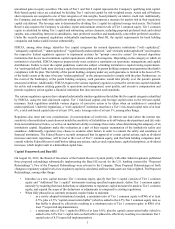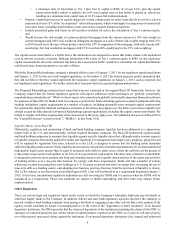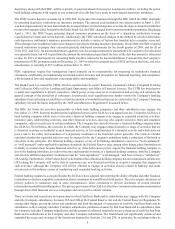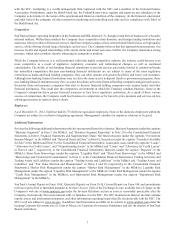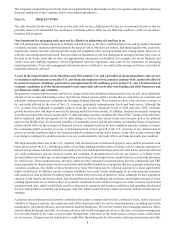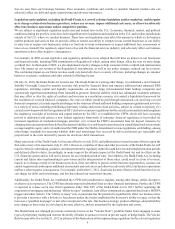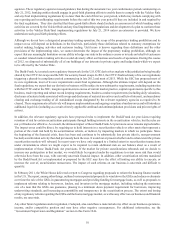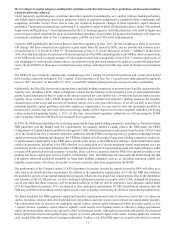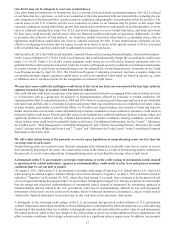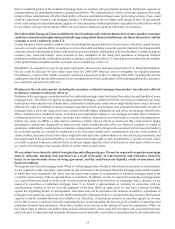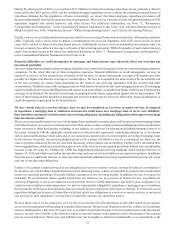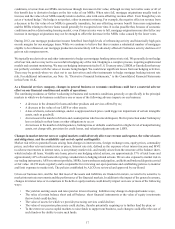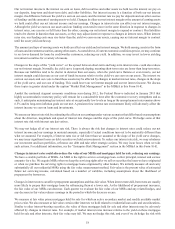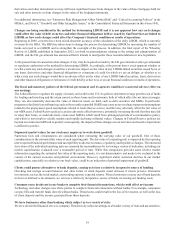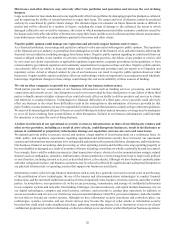SunTrust 2012 Annual Report Download - page 26
Download and view the complete annual report
Please find page 26 of the 2012 SunTrust annual report below. You can navigate through the pages in the report by either clicking on the pages listed below, or by using the keyword search tool below to find specific information within the annual report.10
agencies. These regulatory agencies issued guidance that during the automatic two year conformance period commencing on
July 21, 2012, banking entities should engage in good-faith planning efforts to enable them to comply with the Volcker Rule
and any final implementing regulations by no later than the end of this two year period, which may include complying with
any reporting and recordkeeping requirements before the end of this two year period if they are included in and required by
the final regulations. They also clarified that these good-faith efforts should include an assessment of which banking entity
activities are covered by the Volcker Rule and any final implementing regulations and development of a plan to conform these
activities to the Volcker Rule/final implementing regulations by July 21, 2014 unless an extension is provided. We have
undertaken such good faith planning efforts.
Although we do not have a designated proprietary trading operation, the scope of the proprietary trading prohibition and its
impact on us will depend on definitions in the final rule, particularly those definitions related to statutory exemptions for
market making, hedging activities and customer trading. Until more is known regarding these definitions and the other
provisions of the implementing rules, we cannot determine the impact of the proprietary trading prohibition, although we
expect that any meaningful limitation on our ability to hedge our risks in the ordinary course or to trade on behalf of customers
or conduct related market making activities would adversely affect our business and results of operations. During the course
of 2012, we disposed of substantially all of our holdings of our interests in private equity and hedge funds which we expect
to be affected by the Volcker Rule.
The Dodd-Frank Act created a new regulatory framework for the U.S. OTC derivatives markets with jurisdiction being broadly
shared by the CFTC for swaps and the SEC for security-based swaps. In 2012, the CFTC finalized many of its core regulations
triggering a phased-in compliance period commencing in late 2012 and most of 2013. While the SEC has proposed most of
its core regulations, most of its new requirements await final regulations. Although the ultimate impact will depend on the
final regulations, we expect that our derivatives business will be subject to new substantive requirements, including registration
with the CFTC and/or the SEC, margin requirements in excess of current market practice, capital requirements specific to this
business, trade reporting and robust record keeping requirements, business conduct requirements (including daily valuations,
disclosure of material risks associated with swaps and disclosure of material incentives and conflicts of interest), and mandatory
clearing and exchange trading of all standardized swaps designated by the relevant regulatory agencies as required to be
cleared. These requirements collectively will impose implementation and ongoing compliance burdens on us and will introduce
additional legal risk (including as a result of newly applicable antifraud and antimanipulation provisions and private rights of
action).
In addition, the relevant regulatory agencies have proposed rules to implement the Dodd-Frank Act provisions requiring
retention of risk by certain securitization participants through holding interests in the securitization vehicles, but the rules are
not yet finalized or effective. As a result, the ultimate impact of these Dodd-Frank Act provisions on us remains unpredictable.
The impact on us could be direct, by requiring us to hold interests in a securitization vehicle or other assets that represent a
portion of the credit risk held by the securitization vehicle, or indirect, by impacting markets in which we participate. Since
the beginning of the financial crisis, there has been and continues to be substantially less private (that is, non-government
backed) securitization activity than had previously been the case. It is unclear at present whether and to what extent the private
securitization markets will rebound. In recent years we have only engaged to a limited extent in securitization transactions
under circumstances where we might expect to be required to retain additional risk on our balance sheet as a result of
implementation of these Dodd-Frank Act provisions. If the market for private securitizations rebounds and we decide to
increase our participation in that market, we would likely be required under the regulations to retain more risk than would
otherwise have been the case, with currently uncertain financial impact. In addition, other securitization reforms mandated
by the Dodd-Frank Act or implemented or proposed by the SEC may have the effect of limiting our ability to execute, or
increase the cost of, securitization transactions. The impact of such reforms on our business is uncertain and difficult to
quantify.
In February 2011, the White House delivered a report to Congress regarding proposals to reform the housing finance market
in the U.S. The report, among other things, outlined various potential proposals to wind down the GSEs and reduce or eliminate
over time the role of the GSEs in guaranteeing mortgages and providing funding for mortgage loans, as well as proposals to
implement reforms relating to borrowers, lenders, and investors in the mortgage market, including reducing the maximum
size of a loan that the GSEs can guarantee, phasing in a minimum down payment requirement for borrowers, improving
underwriting standards, and increasing accountability and transparency in the securitization process. The extent and timing
of any regulatory reform regarding the GSEs and the home mortgage market, as well as any effect on our business and financial
results, are uncertain.
Any other future legislation and/or regulation, if adopted, also could have a material adverse effect on our business operations,
income, and/or competitive position and may have other negative consequences. For additional information, see the
“Government Supervision and Regulation” section in this Form 10-K.



